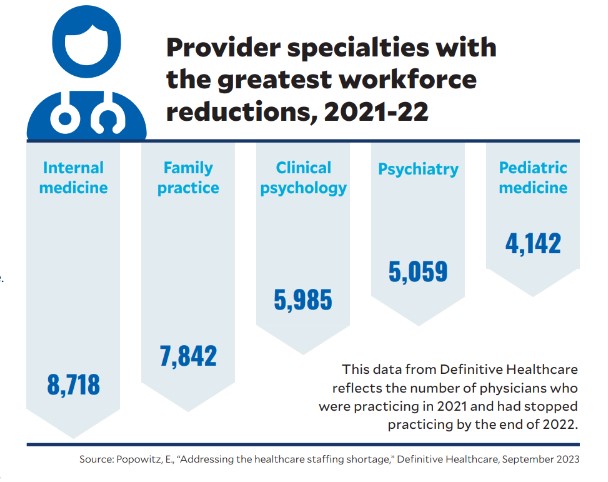News Briefs: Medicare’s hospital outpatient payment rate for 2024 improves marginally from the proposed rule
As published in the Winter 2023 issue of hfm magazine, here is a monthly roundup of top news for healthcare finance professionals.
The final rule setting Medicare’s 2024 payment rates and policies for hospital outpatient services and ambulatory surgical centers (ASCs) contained little to make hospitals optimistic about the government portion of their payer mix.
Base payments for items and services furnished in hospital outpatient settings and ASCs will increase by 3.1% after factoring in the usual 0.2-percentage-point “productivity” decrease. The update will be reduced for hospitals that fail to meet quality-reporting requirements. The increase is up from 2.8% in the proposed rule earlier this year, stemming from changes in market basket inputs.
In comments on the proposed rule, stakeholders said a payment update in the 3% range would not adequately cover heightened expenses. CMS responded that its hands are tied based on statutory guidelines for calculating the market basket increase.
In a written statement about the final rule, the American Hospital Association (AHA) said, “Hospitals’ and health systems’ ability to continue caring for patients and providing essential services for their communities may be in jeopardy, which is why the AHA is urging Congress for additional support by the end of the year.”
A $9 billion remedy for 340B hospitals is set to be distributed soon
Hospitals in November received final details on a $9 billion remedy payment plan for participants in the 340B Drug Pricing Program.
CMS issued a Nov. 2 final rule describing the terms of the remedy payment, which was necessitated after the Supreme Court unanimously ruled in 2022 that the U.S. Department of Health and Human Services had unlawfully reduced Medicare reimbursement for Part B drugs purchased by 340B-participating hospitals starting in 2018.
Medicare administrative contractors will remit the lump-sum payments, which are expected to begin reaching hospitals in early to mid-January. An addendum listing each hospital’s final payment is available for downloading from a CMS webpage. The file indicates more than 240 hospitals are in line for a payment exceeding $10 million.
CMS said the Medicare statute suggests any payment adjustment linked to the payment system for hospital outpatient care — which incorporates the 340B program — must be budget-neutral. As a result, $7.8 billion will be recouped over an estimated 16-year period by trimming the outpatient payment rate for nondrug items and services by 0.5% per year beginning in 2026.
CMS finalizes enhanced hospital price transparency requirements for 2024
Hospital price transparency mandates are set to become more stringent in the coming year as CMS seeks to strengthen regulations that have been on the books since 2021.
Medicare’s 2024 final rule for hospital outpatient payments includes updates to the price transparency rules. Hospitals will need to post charge information using a more precise template, and they face a greater likelihood of being publicly cited for noncompliance.
Stricter technical requirements will be in place starting July 1, including implementation of a new template that will dictate the layout and data specifications of the machine-readable file. The template will be available as a CSV format or JSON schema.
Enforcement actions will be publicized more extensively. Whereas hospitals thus far have been posted on a publicly accessible webpage only if they have been penalized for noncompliance, listings are set to expand to include all hospitals. Each hospital’s listing will indicate whether it is in compliance — and for noncompliant organizations, information will describe the status of enforcement actions, including warnings.
Congress once more delays the Medicaid DSH supplemental payment cut
Legislation passed in mid-November to keep the federal government fully funded until Jan. 19 also delayed the scheduled start of a $32 billion cut to Medicaid disproportionate share hospital (DSH) payments until that date.
The cut, which would span four years, previously was pushed back Sept. 30, a day before it would have begun. The Nov. 14 postponement left a bit more of a cushion — three days. Hospitals now hope Congress acts again within the first few weeks of the new year, ideally by crafting a longer-term solution.
On Nov. 8, the Senate Finance Committee unanimously passed a wide-ranging bill that not only would delay the DSH funding reduction but also would cut it in half. There would be no DSH decrease in FY24 or FY25, with the cut limited to $16 billion over two years starting in FY26.
The bill’s prospects for securing final passage are murky amid the ongoing negotiations over the federal budget, but large groups of senators and representatives this year have signed letters to leadership about the need to avoid dropping a big funding cut on safety-net hospitals.

Medicare physician payments are scheduled to fall again in 2024
Medicare’s 2024 final rule for physician payments includes a $1.15 decrease to the conversion factor, amounting to a reduction of more than 3.3%.
Barring a legislative fix before the end of the year, the conversion factor in 2024 will have fallen by 9.3% since 2020. Meanwhile, based on the Medicare Economic Index, practice costs are projected to rise by 14% during that span (cost data for 2023 and 2024 are subject to change).
The 2024 decrease is driven by budget neutrality requirements stemming from payment increases for certain services, resulting in a negative 2.18% adjustment to the fee schedule. The key factor is the new HCPCS code G2211, which is a “complexity” add-on code for office and outpatient evaluation and management (E/M) services.
The code initially was set to debut in 2021 before Congress passed legislation delaying implementation to reduce the impact of budget neutrality on the fee schedule during the pandemic. Developed to improve payment accuracy, the code captures longitudinal services provided to patients with serious or complex conditions. CMS estimates the code will be used in 38% of office and outpatient E/M visits.





